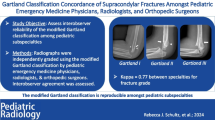Abstract
Purpose
This study compared the accuracy and timeliness of two-dimensional computed tomography (2DCT) and three-dimensional computed tomography (3DCT) in the diagnosis of different types of acetabular fractures and by different groups of interpreters using the Letournel and Judet classification system.
Methods
Twenty-five fractures cases, five each of five common types of acetabular fractures, were selected. Nineteen interpreters with different levels of experience (ten graduate trainees and nine radiologists) individually classified the fractures using multiplanar 2D and standardized 3DCT images. The 3DCT image set was comprised of 39 images of rotational views of the entire pelvis and the disarticulated fracture hip. Consensus reading by three experts served as a reference standard.
Results
Classification accuracy was 66% using 2DCT, increasing to 73% (p = 0.041) when 3DCT was used. Improvement occurred in the interpretation of transverse and posterior wall-type fractures (p < 0.01 and p = 0.015, respectively), but not in T-type, transverse with posterior wall, or both-column fractures. The improvement was noted only in the graduate trainee group (p = 0.016) but not the radiologist group (p = 0.619). Inter-observer reliability in the graduate trainee group improved from poor to moderate with 3DCT, but remained at a moderate level in both 2DCT and 3DCT in the radiologist group. The overall average interpretation time per case with correct diagnosis was 60 s for 2DCT but only 32 s for 3DCT.
Conclusions
Standardized 3DCT provides greater reliability and faster diagnosis of acetabular fractures and helps improve the accuracy in transverse- and posterior wall-type fractures. In addition, it helps improve the accuracy of less experienced interpreters.




Similar content being viewed by others
References
Falchi M, Rollandi GA (2004) CT of pelvic fractures. Eur J Radiol 50(1):96–105. https://doi.org/10.1016/j.ejrad.2003.11.019
Letournel E (1980) Acetabulum fractures: classification and management. Clin Orthop Relat Res 151:81–106
Geijer M, El-Khoury GY (2007) Imaging of the acetabulum in the era of multidetector computed tomography. Emerg Radiol 14(5):271–287. https://doi.org/10.1007/s10140-007-0638-5
Scheinfeld MH, Dym AA, Spektor M, Avery LL, Dym RJ, Amanatullah DF (2015) Acetabular fractures: what radiologists should know and how 3D CT can aid classification. Radiographics 35(2):555–577. https://doi.org/10.1148/rg.352140098
Durkee NJ, Jacobson J, Jamadar D, Karunakar MA, Morag Y, Hayes C (2006) Classification of common acetabular fractures: radiographic and CT appearances. AJR Am J Roentgenol 187(4):915–925. https://doi.org/10.2214/AJR.05.1269
Ohashi K, El-Khoury GY, Abu-Zahra KW, Berbaum KS (2006) Interobserver agreement for Letournel acetabular fracture classification with multidetector CT: are standard Judet radiographs necessary? Radiology 241(2):386–391. https://doi.org/10.1148/radiol.2412050960
O’Toole RV, Cox G, Shanmuganathan K, Castillo RC, Turen CH, Sciadini MF, Nascone JW (2010) Evaluation of computed tomography for determining the diagnosis of acetabular fractures. J Orthop Trauma 24(5):284–290. https://doi.org/10.1097/BOT.0b013e3181c83bc0
Visutipol B, Chobtangsin P, Ketmalasiri B, Pattarabanjird N, Varodompun N (2000) Evaluation of Letournel and Judet classification of acetabular fracture with plain radiographs and three-dimensional computerized tomographic scan. J Orthop Surg (Hong Kong) 8(1):33–37. https://doi.org/10.1177/230949900000800107
Kickuth R, Laufer U, Hartung G, Gruening C, Stueckle C, Kirchner J (2002) 3D CT versus axial helical CT versus conventional tomography in the classification of acetabular fractures: a ROC analysis. Clin Radiol 57(2):140–145. https://doi.org/10.1053/crad.2001.0860
Garrett J, Halvorson J, Carroll E, Webb LX (2012) Value of 3-D CT in classifying acetabular fractures during orthopedic residency training. Orthopedics 35(5):e615–e620. https://doi.org/10.3928/01477447-20120426-12
Clarke-Jenssen J, Ovre SA, Roise O, Madsen JE (2015) Acetabular fracture assessment in four different pelvic trauma centers: have the Judet views become superfluous? Arch Orthop Trauma Surg 135(7):913–918. https://doi.org/10.1007/s00402-015-2223-9
Sebaaly A, Riouallon G, Zaraa M, Upex P, Marteau V, Jouffroy P (2018) Standardized three dimensional computerised tomography scanner reconstructions increase the accuracy of acetabular fracture classification. Int Orthop 42(8):1957–1965. https://doi.org/10.1007/s00264-018-3810-5
Brandser E, Marsh JL (1998) Acetabular fractures: easier classification with a systematic approach. AJR Am J Roentgenol 171(5):1217–1228. https://doi.org/10.2214/ajr.171.5.9798851
Riouallon G, Sebaaly A, Upex P, Zaraa M, Jouffroy P (2018) A new, easy, fast, and reliable method to correctly classify acetabular fractures according to the Letournel System. JB JS Open Access 3(1):e0032. https://doi.org/10.2106/JBJS.OA.17.00032
Koo TK, Li MY (2016) A guideline of selecting and reporting intraclass correlation coefficients for reliability research. J Chiropr Med 15(2):155–163. https://doi.org/10.1016/j.jcm.2016.02.012
Boudissa M, Orfeuvre B, Chabanas M, Tonetti J (2017) Does semi-automatic bone-fragment segmentation improve the reproducibility of the Letournel acetabular fracture classification? Orthop Traumatol Surg Res 103(5):633–638. https://doi.org/10.1016/j.otsr.2017.03.018
Pretorius ES, Fishman EK (1999) Volume-rendered three-dimensional spiral CT: musculoskeletal applications. Radiographics 19(5):1143–1160. https://doi.org/10.1148/radiographics.19.5.g99se061143
Tractenberg RE, Yumoto F, Jin S, Morris JC (2010) Sample size requirements for training to a kappa agreement criterion on clinical dementia ratings. Alzheimer Dis Assoc Disord 24(3):264–268. https://doi.org/10.1097/WAD.0b013e3181d489c6
Acknowledgments
We are grateful to Professor Dan J. Sherman for his technical advice and to G. Lamar Robert for English editing.
Author information
Authors and Affiliations
Contributions
Conceptualization: Nuttaya Pattamapaspong. Methodology: Thanat Kanthawang, Nuttaya Pattamapaspong. Formal analysis and investigation: Thanat Kanthawang, Tanawat Vaseenon, Patumrat Sripan. Writing-original draft preparation: Thanat Kanthawang. Writing-review and editing: Nuttaya Pattamapaspong.
Corresponding author
Ethics declarations
This investigational protocol was conducted in accordance with the guidelines of the Institutional Review Board.
Conflict of interest
The authors declare that they have no conflict of interest.
Additional information
Publisher’s note
Springer Nature remains neutral with regard to jurisdictional claims in published maps and institutional affiliations.
Rights and permissions
About this article
Cite this article
Kanthawang, T., Vaseenon, T., Sripan, P. et al. Comparison of three-dimensional and two-dimensional computed tomographies in the classification of acetabular fractures. Emerg Radiol 27, 157–164 (2020). https://doi.org/10.1007/s10140-019-01744-6
Received:
Revised:
Accepted:
Published:
Issue Date:
DOI: https://doi.org/10.1007/s10140-019-01744-6




